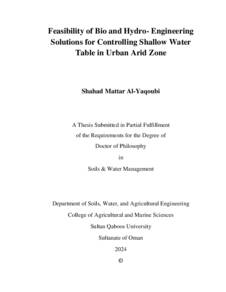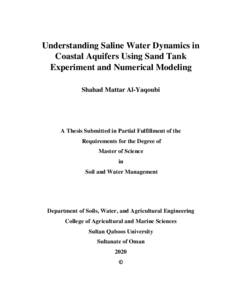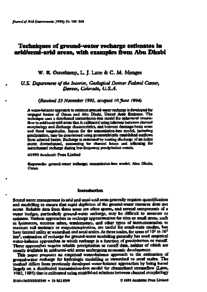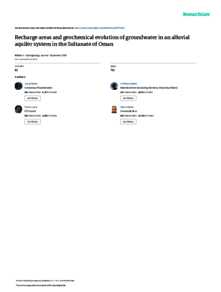وثيقة
Feasibility of bio and hydro-engineering solutions for controlling shallow water table in urban arid zone.
المصدر
Doctoral dissertation
عناوين أخرى
جدوى الحلول الهندسية والايكولوجية لخفض مناسيب المياه الجوفية الضحلة في المناطق الحضرية في البلدان الجافة
الدولة
Oman
مكان النشر
Muscat
الناشر
Sultan Qaboos University
ميلادي
2024
اللغة
الأنجليزية
نوع الرسالة الجامعية
Doctoral dissertation
الملخص الإنجليزي
The shallow water table (SWT) emerged to be a challenge in urbanized areas that are
expected to cause more environmental and geotechnical problems. It is essential to
comprehend the origins, dynamics, and impacts of the SWT issue in cities. It is essential
to explore practical solutions to mitigate this issue in urban areas where SWT conditions
are emerging and have not yet been adequately considered. This thesis investigated the
factors contributing to the increasing SWT problem at Sultan Qaboos University campus
(SQU)_Oman and explored practical solutions to control SWT levels using field
investigation, sand tank and large-scale experiments, and mathematical modeling.
Efficient shallow water management in urban areas hinges on a thorough understanding
of the subsurface hydraulic properties, potential sources of water, and its dynamics.
Understanding the saturated hydraulic conductivity (Ksat) value is important in designing
drainage systems to lower SWT levels. Accurate estimation of effective Ksat of a vadose
zone with an underlying shallow perched aquifer is challenging, especially in
heterogeneous media. Standard pumping tests and double-ring infiltrometers are
unsuitable for the condition of the explored study area. Therefore, Bail-out tests were
conducted in nine soil pits at SQU in Oman to determine the hydraulic properties of the
vadose zone and the shallow perched aquifers. The analytical and numerical (HYDRUS2D) models were also used to estimate the Ksat values. A good match was found between
the field experiment (Bail-out test), HYDRUS-2D, and analytical results for layered and
homogeneous soil conditions, indicating that Bail-out test is a fast and reliable field
method for estimating Ksat. The average Ksat of the study area was found between 2–3
cm/hr.
During field investigation in the first part of this study, we found that the clogging of
drains and subsurface domain can contribute to rise of SWT levels. For that, the second
part of this work investigated the impact of clogged drains on SWT levels. Clogging
problem in this thesis has been linked to clogged drain occurring in the embankment
because the used analytical solution in this study was developed for embankment
condition. The results illustrated that seepage-induced suffusion and translocation of fine
soil fractions from the upstream to the downstream portion of the embankment cause toe
(blanket) drains in levees to become clogged. These particles settle as a cake on top of the
drain, which is typically Terzhagi's graded gravel. Furthermore, "internal colmation"
occurs as a result of the fine particles being moved into the coarse filter materials by the
high hydraulic gradients near the drain. This thesis examined 2-D seepage to a clogged
drain using numerical modeling (HYDRUS-2D) and experimental (sand tank) methods.
We demonstrated using sand tank experiments, how an unclogged and a clogged toe drain,
differ in terms of the seepage flow rate and the location (height) of a phreatic surface. The
results present in this thesis found clogging raises the phreatic surface significantly by
41% for a given levee’s size while lowering the seepage flow rate by 66.7%. Also, we
vii
found the clogged drain can cause the phreatic surface to extend farther downstream along
the embankment compared to an unclogged drain. The HYDRUS-2D results showed
similar results to the sand tank experiment.
After developing a good understanding of the SWT site, the thesis explored the impact
and effectiveness of various potential techniques for managing the SWT level. It is crucial
to investigate potential solutions that could significantly lessen the detrimental effects of
SWT on urban areas. First, as we found in urban areas (such as Muscat, Oman), SWT can
be lowered by managed aquifer discharge through trenches. The drawdown of the water
level in two trenches or a single trench is investigated experimentally (using sand tank
experiments) and numerically using HYDRUS-2D. To evaluate the stability of trench
slopes against seepage-induced erosion, it is important to evaluate the transient flow fields
of pore pressure and hydraulic gradients. Analysis of the sand tank experiments results
showed that the water level drops in trenches’ was rapid but not instantaneous. Our
mathematical models reveal that immediately after a sudden water level drop, the seepage
gradients towards the trenches become critically steep, a finding that is both novel and of
concern for drainage engineers. We determined that a significant amount of time is
required for a stable seepage regime to develop following an abrupt decrease in water
levels within the trenches.
In addition, the technique of using a horizontal draining pipe is important to control SWT
levels. For that, the sand tank’s orifice is represented as a Zhukovsky “slot drain” was
used to understand how the flow rate through the horizontal draining pipe is affected by
pipe properties (such as pipe length and elevation). Our sand tank experiments showed
that the flow rate of water drained directly from the saturated tank via an outlet valve was
63% higher than the flow rate through a connected long plastic pipe into the valve.
Additionally, the flow rate from a pipe elevated 100 cm above the ground surface was
39% lower than the flow rate through a pipe at ground level. Reducing the pipe length by
half resulted in a 50% increase in the water flow rate. According to HYDRUS-2D
simulations, the flow rate of such a drain is nearly identical to that of a sand tank.
This thesis also examined how bioengineering methods operate to reduce SWT levels
within the using of hydropedological method, which includes the structure and texture of
the soil in the vadose zone, which is where the majority of pore water fluxes occur.
Physical models (sand tank experiments) and field-large scale experiments were
performed. Nine sand tanks in all, divided into three separate groups, were used to study
the dynamics of the SWT via various mechanisms: (1) evapotranspiration drawdown
caused by soil water uptake by vegetation roots (e.g., Reeds); (2) direct evaporation from
bare homogeneous topsoil; and (3) evaporative “soil siphoning” in tanks constructed as
“smart composites” featuring a vertical “moisture chimney” with a fine texture soil. Over
six months (March–September 2023), the dynamics of SWT were observed in sand tanks.
The internal dimensions of each tank are 100 cm long, 70 cm high, and 15 cm wide. Two
horizontal soil layers—sand and clay—were packed into each tank to mimic a perched
aquifer, a common model of which was investigated in the study area (Muscat, Sultanate
of Oman). Silt loam soil was put into a tiny trench for the siphoning experiment. This
trench or siphon method increased capillarity and thus accelerated evaporation that led to
a decrease in the SWT level. Analysis of the data revealed that, in comparison to the
viii
control tanks, the water table drawdown in the tanks containing plants (Reeds) varied from
187.5% to 237.3% (winter to summer seasons). Additionally, as compared to the control
tanks, the SWT in the tanks equipped with "soil siphons" was decreased by 36.8%-51.2%.
Also, a larger-scale Reed experiment was carried out in the field utilizing Concrete
Agricultural Basins of 1000 cm in length, 200 cm in width, and 60 cm in depth. The threemonths experiment, which ran from June to September 2023, sought to understand how
Reeds affects and controls the SWT levels in larger-scale 3D pore water dynamics (flows
in the sand tanks were 2D). Generally, the large-scale experiments showed that, compared
to evaporation from unvegetated soil during the first, second, and third months of running
the experiment, respectively, the evapotranspiration rate from Reed’s experiment lowered
the water level by 16.7%, 66.7%, and 120% over the three months of the experiment.
This study demonstrates the important impact of hydropedology of the soil, seasonal
fluctuations of the weather, and bioengineering using phreatophytic Reeds on controlling
the SWT levels. Also, we investigated how strata, designed soil siphons, and fine-textured
soil lenses (layers) affect the control of the water level. Although the presence of Reeds is
a major factor in determining water levels, seasonal variations—which are typically
described by ETo-ETc—also play a part, with summer and winter variations being
particularly noticeable. The investigated drainage techniques are environmentally friendly
and sustainable: no electricity or fuel is used for the reduction of waterlogging because
only soil capillarity and solar energy maintain the processes of evaporation and
transpiration; the Reeds’ biomass, accumulated during the ecoengineering process,
additionally intercepts and sequesters CO2.
Additionally, calibrated MODFLOW and HYDRUS-2D models were used to simulate the
impacts of several parameters on the dynamics of the SWT and evapotranspiration
processes. Through simulations, the impacts of layered heterogeneous aquifer,
evapotranspiration rates, salinity concentrations of groundwater, and siphon thicknesses
are investigated and compared with experimental results (the siphon sand tanks, Reed sand
tanks, and field-large scale experiments). The numerical results showed, compared to an
aquifer that was homogenous, the heterogeneity condition of the aquifer was found to have
a noteworthy effect, coming about in a 20.6% diminishment in evapotranspiration rates in
24 hrs. This led to a decrease in the rate of SWT drop via evapotranspiration. Also, after
48 hrs., the heterogeneous condition showed a 22.5% decrease in evapotranspiration rate
and higher SWT level compared to the homogenous condition. This phenomenon
highlights the ways in which aquifer heterogeneity influences the availability of water for
evapotranspiration, whereby regions with high hydraulic conductivity promote more
effective water capillary rise to the root zone. Lower conductivity ranges, on the other
hand, obstruct the upward water movement essential for evapotranspiration and may cause
a rise of the water table level. Furthermore, diverse evapotranspiration rates had striking
impacts: after 24 hrs, a 50% rise in evapotranspiration rate caused a 5.9% decreased more
in the SWT level, and after 48 hrs caused a further decrease in SWT level by 7.1%. On
the other hand, decreasing evapotranspiration rate by 50% caused to increased SWT level
more by 17.6% and 16.4% after 24 hrs and 48 hrs, respectively. It's interesting to note that
rising SWT levels with increased water salinity levels showed a negative impact on the
effectiveness of evapotranspiration in reducing SWT levels. The presence of impermeable
layers such as roads and buildings foundations, also prevented evaporation from the soil,
ix
which reduced the ability of siphon systems to lower SWT levels. However, variations in
siphon thickness produced different results, with layers of medium thickness being more
successful in promoting evaporation and boosting siphon efficacy. All simulations in this
thesis clarify the complex dynamics influencing the behavior of the SWT, which is needed
for water resource management in urban areas.
Based on our findings, we propose additional research into the combination of drawdown
trenches, horizontal pipes, vegetations and siphon inside city drainage systems. Also, we
recommend further studies to better recognize the complex interactions among ET, aquifer
heterogeneity, water salinity, impermeable layers, and siphon thickness. Utilizing more
advanced numerical simulation techniques can enhance the precision of SWT predictions
and guide informed choice-making in groundwater control (e.g., optimization modeling,
AI, among others).
قالب العنصر
الرسائل والأطروحات الجامعية




